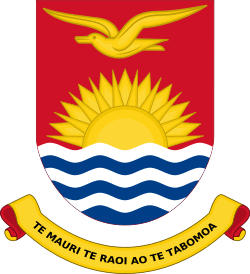1978 Gilbertese parliamentary election
Parliamentary elections were held in the Gilbert Islands on 1 February 1978, with a second round on 6 February.[1]
 |
|---|
| This article is part of a series on the politics and government of Kiribati |
|
Electoral system
The recommendations of the 1977 constitutional convention on a proposed electoral system were introduced prior to the 1978 elections. There were to be 35 members of the House of Assembly, who would be elected from 13 single-member constituencies, 8 two-member constituencies, and 2 three-member constituencies. The three-member constituencies covered South Tarawa, the capital and home to nearly one-third of the entire population of 56,000. For the first time, Christmas, Fanning and Washington Islands, as well as Banaba, each returned one member from their populations of migrant workers and their families.
The 35 members of the House of Assembly were elected from 23 constituencies (with each island forming a constituency) using the two-round system; if no candidate received a majority of the vote in the first round, a second round was held within seven days.[2]
Campaign
All candidates for the 35 seats ran as independents. In three constituencies (two seats on Beru, one on Arorae) the candidates were returned unopposed.[3]
Results
| Party | Votes | % | Seats |
|---|---|---|---|
| Independents | 14,715 | 100 | 35 |
| Invalid/blank votes | 289 | – | – |
| Total | 15,004 | 100 | 35 |
| Registered voters/turnout | 18,523 | 81.0 | – |
| Source: Nohlen et al. | |||
Elected members
| Constituency | Member |
|---|---|
| Abaiang | Taniera Kautoa |
| Teatao Teannaki | |
| Abemama | Teewe Arobati |
| Tekinaiti Kaiteie | |
| Aranuka | Ioane Benna |
| Arorae | Teeta Ioran |
| Banaba | Tabuarorae Taniera |
| Beru | Otiuea Tanentoa |
| Taomati Iuta | |
| Betio | Bwebwentaratai Benson |
| Teburea T. Bakaoti | |
| Roniti Teiwaki | |
| Butaritari | Ieremia Tata |
| Toanimatang Teraoi | |
| Fanning Island | Willie Yee-On |
| Christmas Island | Moiaua Toariri |
| Kuria | Tetimra Taie |
| Maiana | Bwebwetake Areieta |
| Makin | Binata Tetaeka |
| Marakei | Naboua Ratieta |
| Tabeata Tamaiti | |
| Nikunau | Tiwau Awira |
| Nonouti | Etekia Batiua |
| Ieremia Tabai | |
| North Tarawa (Rural Tarawa) | Tenanoa Kanono |
| Teweia Uaruta | |
| Onotoa | Babera Kirata |
| South Tarawa (Urban Tarawa) | Abete Merang |
| Karawaiti Taraia | |
| Toia Taruru | |
| Tabiteuea North | Baraniko Raaba |
| Leo T. Ubaitoi | |
| Tabiteuea South | Teitintau Teitiaua |
| Tamana | Boanareke Boanareke |
| Washington Island | Tetaake Eria |
| Source: Parliament of Kiribati | |
Aftermath
An election for Chief Minister was held on 17 March between Ieremia Tabai, Roniti Teiwaki, Babera Kirata and Taomati Iuta. After Tabai won with 56% of the vote, he appointed a cabinet with Teewe Arobati as Minister for the Line and Phoenix Group, Tiwau Awira as Minister for Finance, Iuta as Minister for Trade, Industry and Labour, Kirata as Minister for Works and Communications, Abete Merang as Minister Health and Community Affairs, Ieremia Tata as Minister for Education, Training and Culture, Teatao Teannaki as Minister for Home Affairs and Teiwaki as Minister for Natural Resource Development. Following independence, Tabai became president, with Teannaki as vice-president.[4]
References
- Dieter Nohlen, Florian Grotz & Christof Hartmann (2001) Elections in Asia: A data handbook, Volume II, p679 ISBN 0-19-924959-8
- Gilbertese at the polls Pacific Islands Monthly, February 1978, p5
- Barrie Macdonald, (1983) Elections in Kiribati Political Science, volume 35, number 1, pp58–70
- Historical Information on Members of the Parliament of Kiribati Parliament of Kiribati